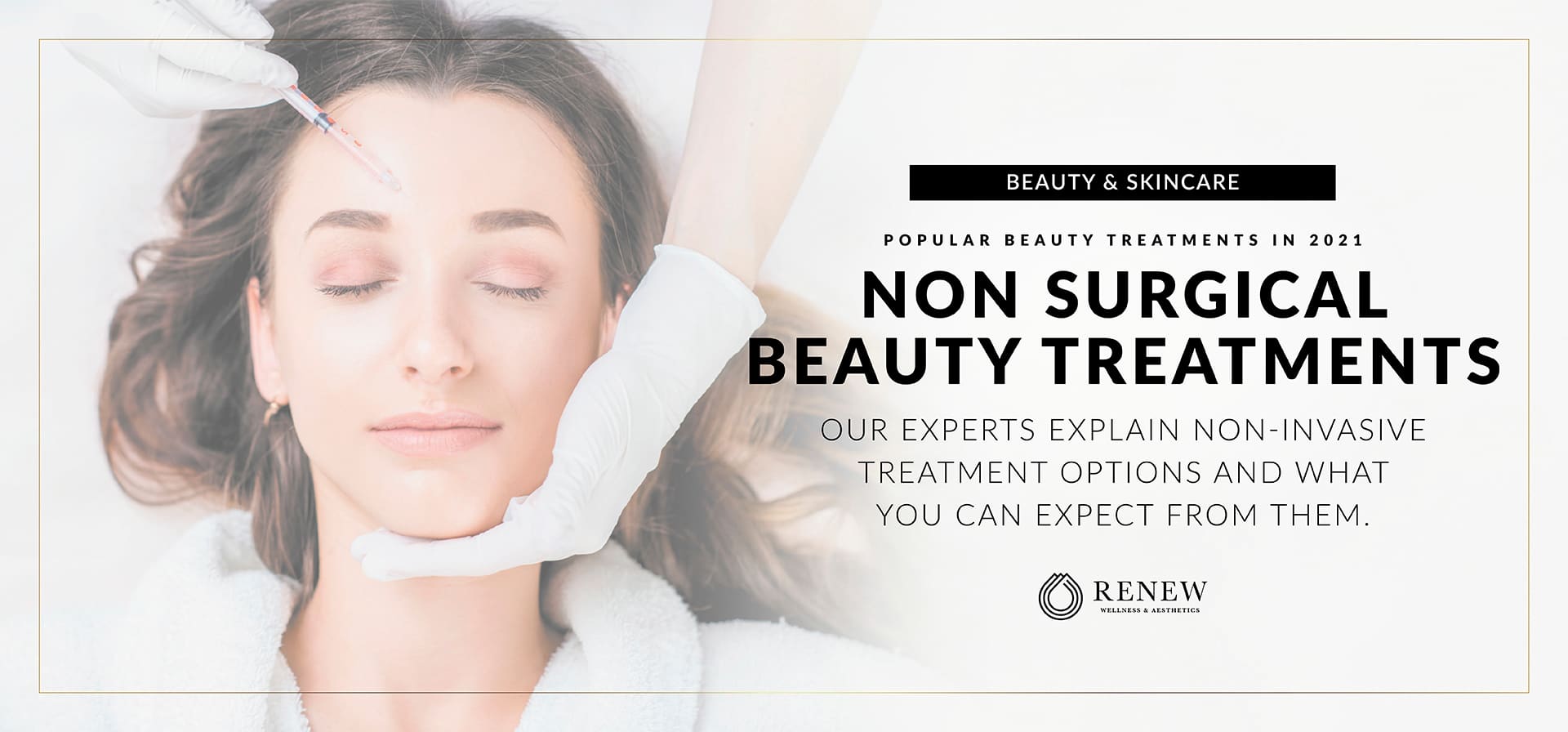According to The American Society of Plastic Surgeons, over 15,700,000 non-invasive beauty treatments to men and women in the US were performed in 2017. Non surgical facelift treatments are a huge hit. They are a perfect option for anyone that wants a less risky procedure for great skin without having to go under the knife.
So, what treatments are considered part of a non surgical facelift? And, what kind of results can you see with them? Since these treatments aren’t nearly as intrusive or as serious as surgery, are the benefits really worth it?
We’re here to tell you about these non-invasive treatment options and what you can expect from them. If you’re interested in making your skin look brighter and younger, but want to avoid surgery, keep reading. Learn about our top non surgical facelift and beauty treatments for 2021 all offered here at Renew.
Microneedling With PRP
What Is Microneedling with PRP?
This cosmetic treatment stimulates new collagen production by rolling tiny needles over the surface of your skin and applying platelets from your blood. It is also referred to as Collagen Induction Therapy. It is a very effective treatment to minimize the signs of aging. Additionally, it can also be effective in treating scarring from acne or certain forms of hyperpigmentation.
PRP (i.e., Platelet Rich Plasma) is plasma derived from your own blood that has a higher concentration of platelets than other parts of the blood. A syringe of blood will be drawn typically from your arm and then put into a centrifuge to separate the plasma from other parts of the blood. Because platelets help with healing due to growth factors and proteins found in the platelets, adding PRP makes the microneedling treatment much more effective.
Although this is one of those cosmetic treatments that sounds a little strange to some, the results are great for someone that wants a minimally invasive treatment option for their skin’s hyperpigmentation, scarring, or wrinkles.
What Can You Expect with Microneedling?
The provider will use a microneedling tool such as the SkinPen to gently roll over and prick the top layer of your skin. This will create tiny holes in your skin through which the provider can apply the PRP.
When the provider adds the PRP, your collagen production and healing process should increase.
Does Microneedling Hurt?
Microneedling is a pretty painless procedure overall. A topical numbing cream is applied to the area prior to the treatment. You might experience a little discomfort, but avoiding products that make your skin sensitive before the treatment, like exfoliants or acids, can help minimize any pain.
How Many Microneedling Treatments Are Required?
Typically, a series of 3 microneedling treatments, spaced 4-6 weeks apart, is recommended for the best results. For patients suffering from acne scarring, oftentimes 4-6 treatments might be needed.
Diamond Glow Facial
Our Diamond Glow Facial, which is also known as a hydradermabrasion procedure, helps to exfoliate the outer layer of your skin. Beauty treatments that focus on exfoliation aim to remove surface-level, dull skin cells to reveal fresher skin underneath.
This treatment is different from microdermabrasion because your provider will use a customized solution with oxygen instead of microcrystals.
The results might be similar to microdermabrasion, but hydradermabrasion is also able to hydrate and improve circulation to the skin. After the removal of the dead skin cells, your skin could experience an increase in collagen production as well.
In addition to reducing fine lines and wrinkles, a Diamond Glow facial is also effective in treating hyperpigmentation, pore congestion, sun damage, dryness, oily skin, and uneven skin texture.
What Can You Expect with Diamond Glow Facials?
The provider will use a diamond tip device to exfoliate, extract, and infuse a customized serum into the skin.
The device used has different treatment tips each designed for a different skin type and texture. A variety of topical solutions will be applied to your skin as well for maximum effectiveness.
Does a Diamond Glow Facial Hurt?
The Diamond Glow treatment is not painful and can actually be very relaxing.
How Many Diamond Glow Treatments Are Required?
To jumpstart your new skin, a series of 3 treatments is recommended 4 weeks apart. For maintenance, we recommend a Diamond Glow every 2 months. However, even just one Diamond Glow facial will rejuvenate your skin for up to 6 weeks!
Chemical Peel OKC
A chemical peel is a popular treatment for people that are looking for brighter, clearer skin.
Chemical peels are offered at different strength levels, so some treatments can be done quickly when you have a break from work while others may require more recovery time.
Chemical peels are an extremely popular option for any person that wants to get rid of wrinkles, acne scars, or sun damage. They are one of the most effective non-invasive treatments you can get.
What Can You Expect From A Chemical Peel?
Chemical peels use chemicals (mainly acids) to deeply exfoliate your skin.
The acids applied by the provider will remove an even amount of dull, damaged, or dead skin cells across your skin. The types of acids used will be different depending on your skin type, your skin concerns and other factors. Examples of acids used in chemical peels include glycolic acid, lactic acid, salicylic acid, retinoic acid, and trichloroacetic acid (TCA).
The skin you can see on your face is the epidermis, and the dermis is what sits right underneath it. If you choose a stronger peel, the treatment goes deeper into the skin.
Does A Chemical Peel Hurt?
If you opt for a stronger level of chemicals, you could have red or even scabbing skin. We know this sounds scary, but rest assured that it is normal for the stronger treatment levels. Once it heals, you won’t regret it for even a second!
If you decide to choose a lower level of strength, you won’t experience much more than some temporary redness and sensitivity.
How Many Chemical Peel Treatments Are Required?
The number of chemical peels recommended greatly depends on the skin concern being treated. Light chemical peels can typically be performed once a month. For acne-prone patients, light chemical peels may be recommended even as frequently as every 1-2 weeks until the desired treatment outcome is reached.
Medium strength peels can be performed every 4-6 months, or 2-3 times per year. Deep chemical peels are typically recommended once every 1-3 years.
Hyaluronic Acid Filler
These are a popular type of dermal fillers that reduce the appearance of wrinkles and fine lines.
Because hyaluronic acid is part of our skin already, the hyaluronic acid in the filler attracts more water to the surface of your skin. This will give your skin a full, plump look that makes you look more youthful!
Hyaluronic acid in any form is important for a hydrated skin complexion, and it is essential for the skin to retain water. As a result, these fillers are useful anywhere on your face.
Beware, however, of the “Hyaluron Pen” as this device is not FDA-approved and can be very unsafe. We have performed correction work for many of our patients after being treated by such a device. This device and several others like it, are being marketed on social media and across the internet as an “innovative” new injection device that can inject hyaluronic acid filler into the skin without using a needle. There are a tremendous amount of Hyaluron Pen gone wrong cases that cause us great concern.
What Can You Expect with Hyaluronic Acid Filler?
The provider will inject the hyaluronic acid through a needle or a cannula. After the needle or cannula is in the correct skin layer, the provider will simply inject the appropriate amount of the gel into your skin!
Does Hyaluronic Acid Filler Hurt?
A lot of fillers are mixed with lidocaine, so you luckily won’t feel much during the treatment. Topical numbing agents are often used prior to the treatment to increase patient comfort. It can sometimes be a little painful, but that pain doesn’t last long.
How Many Hyaluronic Acid Treatments Are Required?
Hyaluronic acid filler can last anywhere from 6 months – 2 years, depending on the type of filler and area treated.
Laser Skin Resurfacing
Laser skin resurfacing removes skin layers with exact, uniform precision. The new skin cells will form, and they will have a much younger look than the removed layers.
Laser skin resurfacing is a great option if you want a non-invasive cosmetic procedure that targets wrinkles and signs of aging. This treatment can be used around the mouth, eyes, forehead, or your entire face and neck.
If you decide to get your whole face treated, the provider will likely numb the parts of your face that are being treated.
Opus Plasma is a newer type of laser skin resurfacing treatment we offer at Renew Wellness & Aesthetics that utilizes state of the art technology. Because Opus Plasma uses plasma energy instead of light energy (like other lasers including the fraxel laser), it smooths the top surface of the skin and heats the lower layers, causing them to produce more collagen.
What Can You Expect From Laser Resurfacing?
The provider will provide the numbing agent as needed, and then move the device over your treatment area. After the treatment, you may need to apply hydrating ointment to help with hydration and healing. You can expect one to two days of a sunburned look but generally can resume normal activities quickly.
Does Laser Resurfacing Hurt?
We use a topical pharmaceutical numbing cream to alleviate any discomfort. We also adjust settings on the device to alleviate any pain or discomfort. Most patients report minimal pain with Opus Plasma laser.
Unlike a Fraxel laser treatment which can take up to an hour, the Opus Plasma laser treatment only takes about 15 minutes!
How Many Opus Laser Treatments Are Required?
We typically recommend a series of three treatments, spaced 3-4 weeks apart for best results. However, even just one Opus Plasma laser treatment will create beautiful skin rejuvenation results!
Botox and Dysport
You cannot have a list of popular beauty treatments to help you achieve a non surgical facelift without mentioning Botox and Dysport.
These are some of the most commonly requested treatments, with 7.44 million procedures completed in 2019 alone. Since then, their popularity has only increased!
Botox and Dysport relax your muscles in place to minimize wrinkles and fine lines. Because you aren’t able to use those muscles as you did before the treatment, the wrinkles don’t crease like they usually would.
We have a complete guide to the difference between Botox and Filler to help you determine which one is right for you.
What Can You Expect From Botox or Fillers?
Both of these treatments are injections, so the provider will administer them with a needle. You’ll typically have targeted areas with this treatment, so the provider will focus on those areas.
Does Botox Hurt?
Some people say that the injection itself feels like a small sting. It is hardly noticeable and goes away as soon as it comes on. After the treatment, you shouldn’t notice any type of pain.
How Often Are Botox or Dysport Treatments Needed?
We recommend Botox or Dysport treatments every 3-4 months.
Are You Interested in a Non Surgical FaceLift?
Dealing with skin that doesn’t look its best is worrisome. Luckily, there are treatments available to help you get the skin you’ve been looking for and at Renew, we’re committed to helping our patients achieve a natural look.
If you’re ready for a non surgical facelift, any of these treatment options may be a good fit for you.
Are you ready to start on the path towards brighter, younger skin? Contact us at Renew Wellness & Aesthetics today to see which is the best option for your targeted skin concerns.

